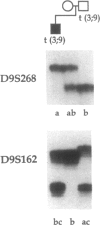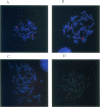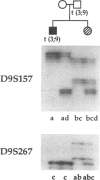Abstract
A child with phenotypic features of the 9p- syndrome, including metopic craniosynostosis, small ears, abdominal wall defect, and mental retardation, as well as hypopigmentation, was found to have a cytogenetically balanced 3;9 translocation, with breakpoints at 3p11 and 9p23, inherited from his phenotypically normal father. Molecular analysis showed heterozygous deletion of the TYRP (tyrosinase-related protein) locus, as well as loci D9S157, D9S274, D9S268, and D9S267, in the child but in neither parent. FISH analysis of the proband's father indicated that loci deleted in his son, including TYRP, were present on neither the der(3) nor the der(9) translocation products but had been inserted into the long arm of chromosome 8. Therefore, the apparent deletion of these loci in the proband was the result of meiotic segregation of the father's 3;9 translocation chromosomes together with his normal chromosome 8 (not bearing the insertion from 9p23). Neither the deletion of these 9p23 loci from the translocation chromosomes nor their insertion into 8q was detectable by standard chromosome banding techniques. The proband's sister exhibited speech delay, mild facial dysmorphism, and renal malformation, and her karyotype was 46,XX. Molecular analysis showed that she had inherited normal chromosomes 3 and 9, as well as the chromosome 8 with the insertion of 9p23 material, from her father.(ABSTRACT TRUNCATED AT 250 WORDS)
Full text
PDF







Images in this article
Selected References
These references are in PubMed. This may not be the complete list of references from this article.
- Aldridge J., Kunkel L., Bruns G., Tantravahi U., Lalande M., Brewster T., Moreau E., Wilson M., Bromley W., Roderick T. A strategy to reveal high-frequency RFLPs along the human X chromosome. Am J Hum Genet. 1984 May;36(3):546–564. [PMC free article] [PubMed] [Google Scholar]
- Baldini A., Ross M., Nizetic D., Vatcheva R., Lindsay E. A., Lehrach H., Siniscalco M. Chromosomal assignment of human YAC clones by fluorescence in situ hybridization: use of single-yeast-colony PCR and multiple labeling. Genomics. 1992 Sep;14(1):181–184. doi: 10.1016/s0888-7543(05)80303-9. [DOI] [PubMed] [Google Scholar]
- Bodrug S. E., Roberson J. R., Weiss L., Ray P. N., Worton R. G., Van Dyke D. L. Prenatal identification of a girl with a t(X;4)(p21;q35) translocation: molecular characterisation, paternal origin, and association with muscular dystrophy. J Med Genet. 1990 Jul;27(7):426–432. doi: 10.1136/jmg.27.7.426. [DOI] [PMC free article] [PubMed] [Google Scholar]
- Breg W. R., Miller D. A., Allderdice P. W., Miller O. J. Identification of translocation chromosomes by quinacrine fluorescence. Am J Dis Child. 1972 Jun;123(6):561–564. doi: 10.1001/archpedi.1972.02110120085007. [DOI] [PubMed] [Google Scholar]
- Centerwall W. R., Beatty-DeSana J. W. The trisomy 9p syndrome. Pediatrics. 1975 Nov;56(5):748–755. [PubMed] [Google Scholar]
- Feinberg A. P., Vogelstein B. A technique for radiolabeling DNA restriction endonuclease fragments to high specific activity. Anal Biochem. 1983 Jul 1;132(1):6–13. doi: 10.1016/0003-2697(83)90418-9. [DOI] [PubMed] [Google Scholar]
- Frydman M., Kauschansky A., Elian E. Trigonocephaly: a new familial syndrome. Am J Med Genet. 1984 May;18(1):55–59. doi: 10.1002/ajmg.1320180109. [DOI] [PubMed] [Google Scholar]
- Fryns J. P., Kleczkowska A., Kubień E., Van den Berghe H. Excess of mental retardation and/or congenital malformation in reciprocal translocations in man. Hum Genet. 1986 Jan;72(1):1–8. doi: 10.1007/BF00278808. [DOI] [PubMed] [Google Scholar]
- Gardner J. M., Nakatsu Y., Gondo Y., Lee S., Lyon M. F., King R. A., Brilliant M. H. The mouse pink-eyed dilution gene: association with human Prader-Willi and Angelman syndromes. Science. 1992 Aug 21;257(5073):1121–1124. doi: 10.1126/science.257.5073.1121. [DOI] [PubMed] [Google Scholar]
- Giacalone J. P., Francke U. Common sequence motifs at the rearrangement sites of a constitutional X/autosome translocation and associated deletion. Am J Hum Genet. 1992 Apr;50(4):725–741. [PMC free article] [PubMed] [Google Scholar]
- Gyapay G., Morissette J., Vignal A., Dib C., Fizames C., Millasseau P., Marc S., Bernardi G., Lathrop M., Weissenbach J. The 1993-94 Généthon human genetic linkage map. Nat Genet. 1994 Jun;7(2 Spec No):246–339. doi: 10.1038/ng0694supp-246. [DOI] [PubMed] [Google Scholar]
- Hennekam R. C., Van den Boogaard M. J. Autosomal dominant craniosynostosis of the sutura metopica. Clin Genet. 1990 Nov;38(5):374–377. doi: 10.1111/j.1399-0004.1990.tb03598.x. [DOI] [PubMed] [Google Scholar]
- Hook E. B., Cross P. K. Rates of mutant and inherited structural cytogenetic abnormalities detected at amniocentesis: results on about 63,000 fetuses. Ann Hum Genet. 1987 Jan;51(Pt 1):27–55. doi: 10.1111/j.1469-1809.1987.tb00864.x. [DOI] [PubMed] [Google Scholar]
- Huret J. L., Leonard C., Forestier B., Rethoré M. O., Lejeune J. Eleven new cases of del(9p) and features from 80 cases. J Med Genet. 1988 Nov;25(11):741–749. doi: 10.1136/jmg.25.11.741. [DOI] [PMC free article] [PubMed] [Google Scholar]
- Jackson I. J., Chambers D., Rinchik E. M., Bennett D. C. Characterization of TRP-1 mRNA levels in dominant and recessive mutations at the mouse brown (b) locus. Genetics. 1990 Oct;126(2):451–459. doi: 10.1093/genetics/126.2.451. [DOI] [PMC free article] [PubMed] [Google Scholar]
- Jacobs P. A. Correlation between euploid structural chromosome rearrangements and mental subnormality in humans. Nature. 1974 May 10;249(453):164–165. doi: 10.1038/249164a0. [DOI] [PubMed] [Google Scholar]
- Lalande M., Dryja T. P., Schreck R. R., Shipley J., Flint A., Latt S. A. Isolation of human chromosome 13-specific DNA sequences cloned from flow sorted chromosomes and potentially linked to the retinoblastoma locus. Cancer Genet Cytogenet. 1984 Dec;13(4):283–295. doi: 10.1016/0165-4608(84)90073-6. [DOI] [PubMed] [Google Scholar]
- Lichter P., Tang C. J., Call K., Hermanson G., Evans G. A., Housman D., Ward D. C. High-resolution mapping of human chromosome 11 by in situ hybridization with cosmid clones. Science. 1990 Jan 5;247(4938):64–69. doi: 10.1126/science.2294592. [DOI] [PubMed] [Google Scholar]
- Murty V. V., Bouchard B., Mathew S., Vijayasaradhi S., Houghton A. N. Assignment of the human TYRP (brown) locus to chromosome region 9p23 by nonradioactive in situ hybridization. Genomics. 1992 May;13(1):227–229. doi: 10.1016/0888-7543(92)90228-k. [DOI] [PubMed] [Google Scholar]
- Nicholls R. D., Knoll J. H., Butler M. G., Karam S., Lalande M. Genetic imprinting suggested by maternal heterodisomy in nondeletion Prader-Willi syndrome. Nature. 1989 Nov 16;342(6247):281–285. doi: 10.1038/342281a0. [DOI] [PMC free article] [PubMed] [Google Scholar]
- Nielsen J., Wohlert M. Chromosome abnormalities found among 34,910 newborn children: results from a 13-year incidence study in Arhus, Denmark. Hum Genet. 1991 May;87(1):81–83. doi: 10.1007/BF01213097. [DOI] [PubMed] [Google Scholar]
- Philip N., Mattei M. G., Pellissier M. C., Mattei J. F., Giraud F. Remaniements chromosomiques équilibrés à phénotype anormal. J Genet Hum. 1988 Jan;36(1-2):37–43. [PubMed] [Google Scholar]
- Puissant H., Azoulay M., Serre J. L., Piet L. L., Junien C. Molecular analysis of a reciprocal translocation t(5;11) (q11;p13) in a WAGR patient. Hum Genet. 1988 Jul;79(3):280–282. doi: 10.1007/BF00366252. [DOI] [PubMed] [Google Scholar]
- Roland B., Lowry R. B., Cox D. M., Ferreira P., Lin C. C. Familial complex chromosomal rearrangement resulting in duplication/deletion of 6q14 to 6q16. Clin Genet. 1993 Mar;43(3):117–121. doi: 10.1111/j.1399-0004.1993.tb04434.x. [DOI] [PubMed] [Google Scholar]
- Smeets D. F., Hamel B. C., Nelen M. R., Smeets H. J., Bollen J. H., Smits A. P., Ropers H. H., van Oost B. A. Prader-Willi syndrome and Angelman syndrome in cousins from a family with a translocation between chromosomes 6 and 15. N Engl J Med. 1992 Mar 19;326(12):807–811. doi: 10.1056/NEJM199203193261206. [DOI] [PubMed] [Google Scholar]
- Temple I. K., Cockwell A., Hassold T., Pettay D., Jacobs P. Maternal uniparental disomy for chromosome 14. J Med Genet. 1991 Aug;28(8):511–514. doi: 10.1136/jmg.28.8.511. [DOI] [PMC free article] [PubMed] [Google Scholar]
- Tommerup N., Brandt C. A., Pedersen S., Bolund L., Kamper J. Sex dependent transmission of Beckwith-Wiedemann syndrome associated with a reciprocal translocation t(9;11)(p11.2;p15.5). J Med Genet. 1993 Nov;30(11):958–961. doi: 10.1136/jmg.30.11.958. [DOI] [PMC free article] [PubMed] [Google Scholar]
- Wagstaff J., Shugart Y. Y., Lalande M. Linkage analysis in familial Angelman syndrome. Am J Hum Genet. 1993 Jul;53(1):105–112. [PMC free article] [PubMed] [Google Scholar]
- Wang H., McLaughlin M., Thompson C., Hunter A. G. Use of fluorescence in situ hybridization to confirm the interpretation of a balanced complex chromosome rearrangement ascertained through prenatal diagnosis. Am J Med Genet. 1993 Jun 15;46(5):559–562. doi: 10.1002/ajmg.1320460520. [DOI] [PubMed] [Google Scholar]
- Warburton D. De novo balanced chromosome rearrangements and extra marker chromosomes identified at prenatal diagnosis: clinical significance and distribution of breakpoints. Am J Hum Genet. 1991 Nov;49(5):995–1013. [PMC free article] [PubMed] [Google Scholar]
- Weksberg R., Teshima I., Williams B. R., Greenberg C. R., Pueschel S. M., Chernos J. E., Fowlow S. B., Hoyme E., Anderson I. J., Whiteman D. A. Molecular characterization of cytogenetic alterations associated with the Beckwith-Wiedemann syndrome (BWS) phenotype refines the localization and suggests the gene for BWS is imprinted. Hum Mol Genet. 1993 May;2(5):549–556. doi: 10.1093/hmg/2.5.549. [DOI] [PubMed] [Google Scholar]









